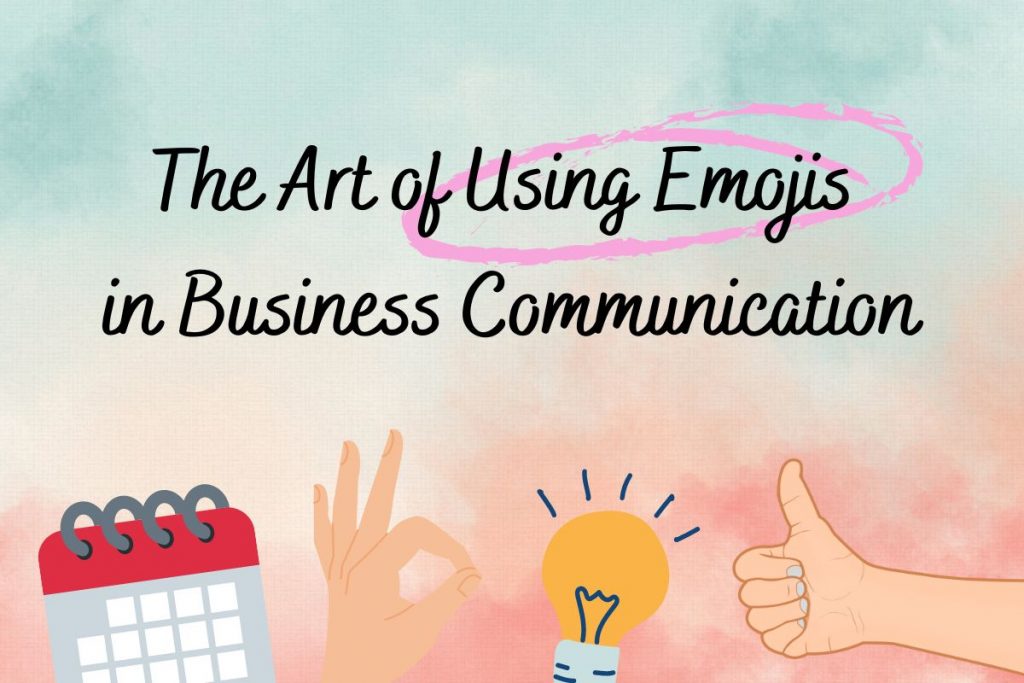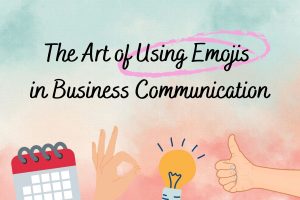The Art of Using Emojis in Business Communication ✍️


Emojis have become an increasingly popular way to convey emotions, ideas, and messages in business communication. While some may dismiss emojis as unprofessional or juvenile, they can enhance communication and help build stronger relationships with customers, colleagues, and partners when used appropriately.
The Role of Emojis in the Connected World
Emojis play an essential role in the connected world by providing a way to convey tone, emotion, and meaning in digital communication. As more and more of our interactions move online, emojis have become essential for expressing ourselves and connecting with others.
Here are some ways that emojis are impacting the connected world:
1. Breaking down language barriers
Emojis are universal symbols that can be understood across cultures and languages. They provide a way to communicate without relying solely on written language, making it easier for people worldwide to connect and understand each other.
2. Enhancing emotional expression
In digital communication, it can be difficult to convey tone and emotion through text alone. Therefore, emojis provide a visual cue to help express how the sender feels, making it easier to interpret the intended meaning of a message.
3. Facilitating communication in brief moments
In a world where communication often happens in short bursts, such as text messages and social media posts, emojis provide a way to communicate quickly and efficiently. They can convey a lot of meaning in just a few characters, making it possible to communicate effectively even when time is limited.
4. Supporting brand identity
Emojis are becoming increasingly important in branding and marketing. Hence, more companies are using custom emojis to build brand awareness and create a unique personality for their brand. Companies can use emojis consistently in their communication to create a strong visual identity that resonates with their audience.
5. Driving innovation
As emojis become more popular and widely used, they drive innovation in digital communication. New emojis are constantly being added to the Unicode standard, providing new ways to express ourselves and communicate with others.
In fact, emojis are increasingly important in the connected world by enhancing communication, breaking down language barriers, supporting branding efforts, and driving innovation in digital communication. Emojis will evolve as our interactions continue to move online and play an even more prominent communication role.
Tips For Using Emojis Effectively in Business Communication
1. Understand the meaning
Before using an emoji, make sure you understand its importance. Different platforms may interpret emojis differently, so be mindful of how your audience might perceive them. It’s also important to avoid using offensive or inappropriate emojis.
2. Use sparingly
While emojis can help convey emotion and tone, using them excessively can be distracting and unprofessional. Use them sparingly to highlight key points or add emphasis.
3. Know your audience
Be mindful of who you’re communicating with and adjust your use of emojis accordingly. Some audiences, such as older or more formal colleagues or customers, may not be as receptive to emojis as others.
4. Keep it professional
While emojis can be fun and playful, remember that you’re still communicating in a professional setting. Avoid using overly colloquial or slang terms, and keep your emoji use appropriate to the context of the conversation.
5. Use them to enhance, not replace, language
Emojis should be used to supplement, not replace, written language. Use them to add emotion, humor, or emphasis to your message, but rely on something other than them to convey important information.
6. Be consistent
If you use emojis regularly in your communication, be consistent in your use of them. This can help create a consistent tone and personality for your brand or communication style.
In conclusion, the use of emojis in business communication can be an effective tool to convey tone and emotion and help build stronger relationships with your audience. However, it’s essential to use them appropriately and in moderation while keeping in mind the context and audience of your communication. By following these tips, you can enhance your communication with colleagues, clients, and dedicated software developers professionally, effectively, and engagingly.
Emojis That Are Safe to Use At Work
While emojis may seem unprofessional for use in a work setting, many are generally considered safe and acceptable. Here are some examples of emojis that are usually safe to use at work:
- 👍 Thumbs Up – Indicate agreement, approval, or a job well done.
- 🙂 Slightly Smiling Face – A simple and friendly way to express positivity or agreement.
- 👌 OK Hand – Used to indicate something is good or acceptable.
- ✅ Check Mark Button – A symbol of completion or verification.
- 💡 Light Bulb – Used to suggest an idea or inspiration.
- 🤝 Handshake – A professional way to express agreement, cooperation, or congratulations.
- 💼 Briefcase – A symbol of work or business-related matters.
- 📅 Calendar – Used to indicate scheduling or necessary dates.
- 💰 Money Bag – Used to represent finance or money-related matters.
- ✍️ Writing Hand – Used to indicate writing, note-taking, or documenting.
It’s essential to remember that the appropriateness of using emojis at work may vary depending on the company culture, industry, and specific communication context. Therefore, always be mindful of the audience and communication tone when deciding whether to use an emoji.
Emojis That You Should Avoid At Work
While many emojis are safe to use in a work setting, some are generally considered inappropriate, unprofessional, or potentially offensive. Here are some examples of emojis that you should avoid using at work:
- Strong language or suggestive emojis: Emojis that contain strong language or sexual innuendo is not appropriate for use in a professional setting. This includes emojis like 🤬, 🤯, 🍆, 🍑, and 🍌.
- Hostile or angry emojis: Emojis that express anger or negativity can be perceived as unprofessional or confrontational. This includes emojis like 😡, 😠, and 🤬.
- Party or drinking emojis: Emojis that suggest excessive partying or drinking are inappropriate or unprofessional in a work setting. This includes emojis like 🍻, 🥂, 🍸, and 🍹.
- Religious or political emojis: Using emojis related to religion or politics can be divisive and potentially offensive. It’s generally best to avoid using emojis like 🙏, ✝️, 🕉️, 🇺🇸, 🇨🇳, or 🇮🇱 in a work setting.
- Personal or romantic emojis: Emojis that suggest intimacy or romantic interest are inappropriate for use in a professional setting. This includes emojis like ❤️, 😘, 💋, and 💕.
Remember that the appropriateness of using emojis at work may vary depending on the company culture, industry, and specific communication context. Finally, always be mindful of the audience and communication tone when deciding whether to use an emoji.

